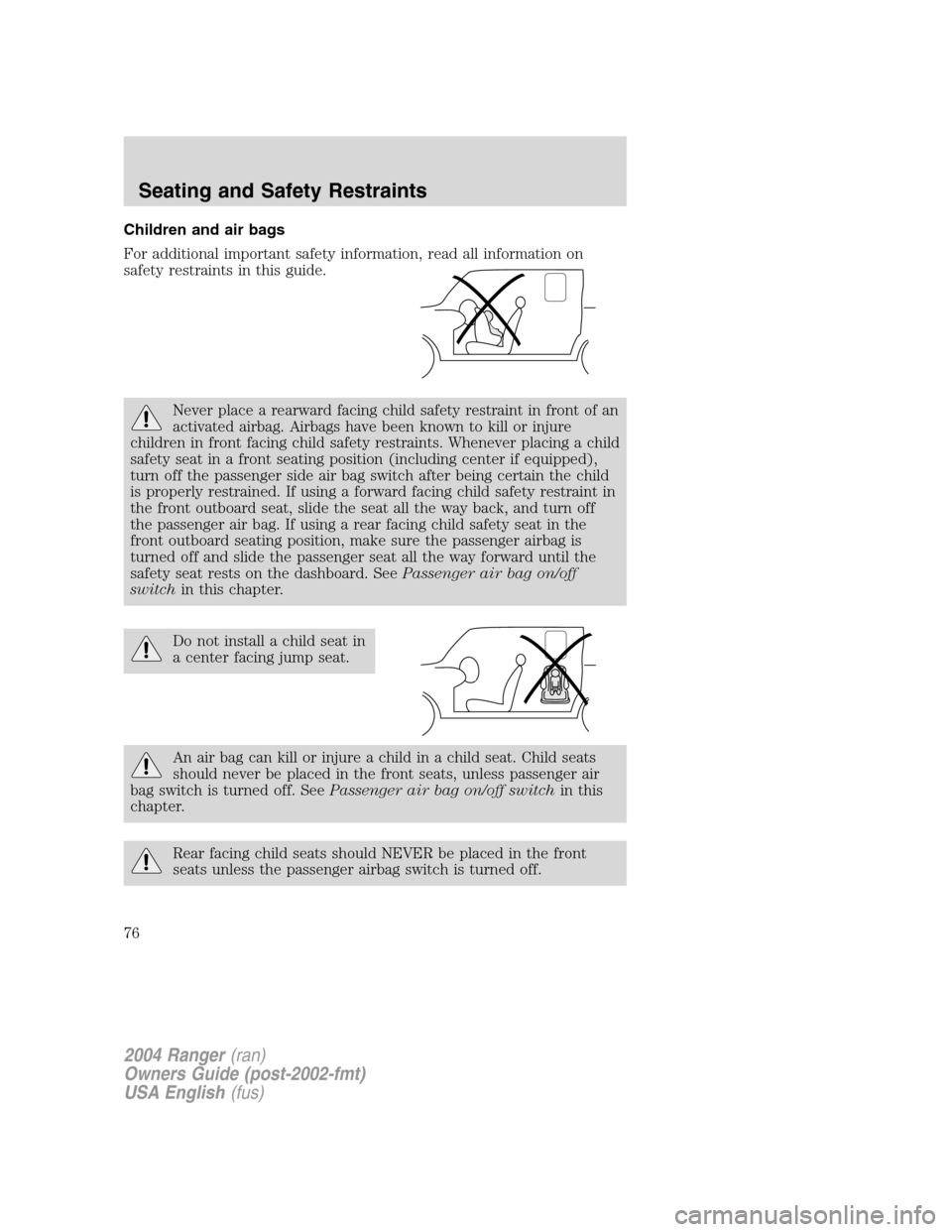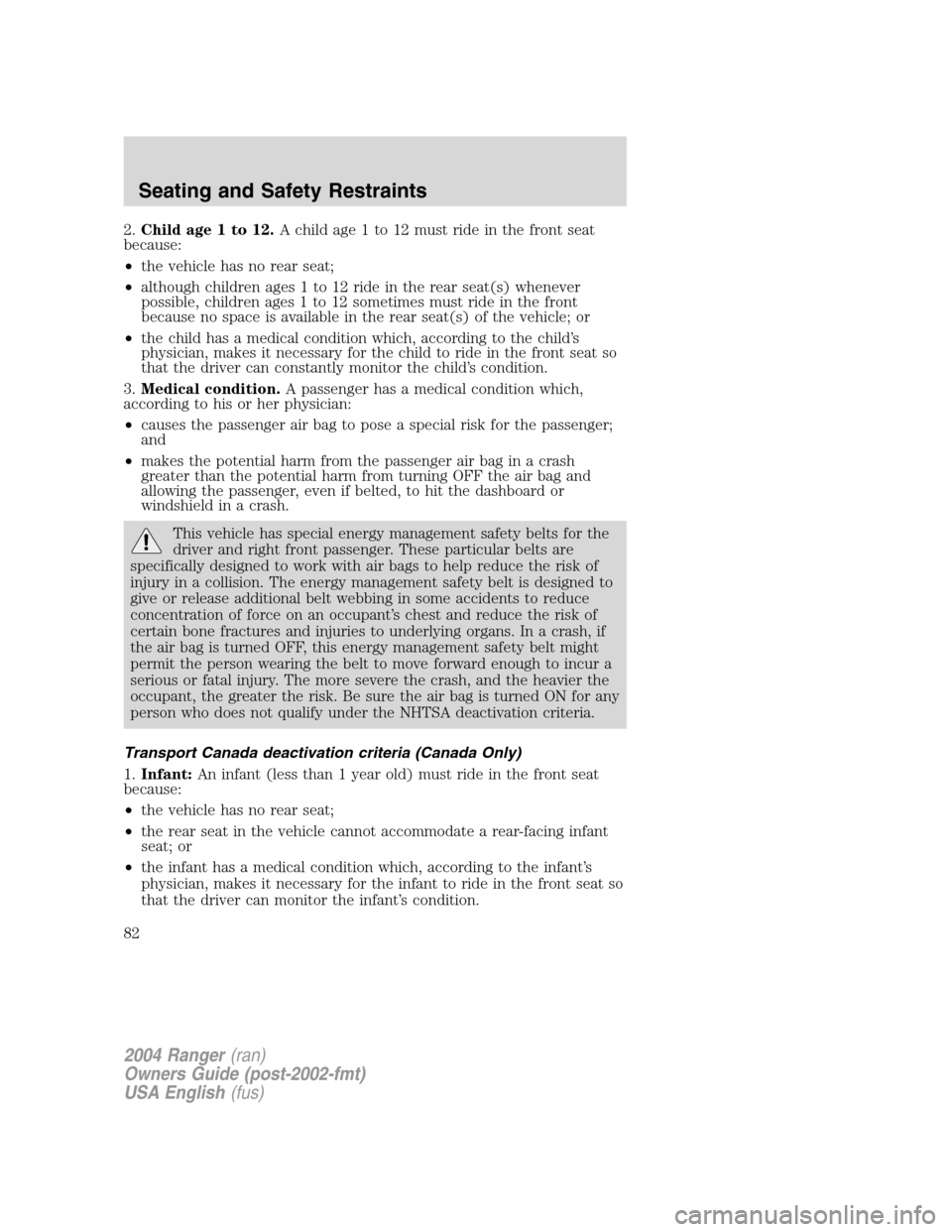dashboard FORD RANGER 2004 2.G Owners Manual
[x] Cancel search | Manufacturer: FORD, Model Year: 2004, Model line: RANGER, Model: FORD RANGER 2004 2.GPages: 248, PDF Size: 6.16 MB
Page 76 of 248

Children and air bags
For additional important safety information, read all information on
safety restraints in this guide.
Never place a rearward facing child safety restraint in front of an
activated airbag. Airbags have been known to kill or injure
children in front facing child safety restraints. Whenever placing a child
safety seat in a front seating position (including center if equipped),
turn off the passenger side air bag switch after being certain the child
is properly restrained. If using a forward facing child safety restraint in
the front outboard seat, slide the seat all the way back, and turn off
the passenger air bag. If using a rear facing child safety seat in the
front outboard seating position, make sure the passenger airbag is
turned off and slide the passenger seat all the way forward until the
safety seat rests on the dashboard. See Passenger air bag on/off
switch in this chapter.
Do not install a child seat in
a center facing jump seat.
An air bag can kill or injure a child in a child seat. Child seats
should never be placed in the front seats, unless passenger air
bag switch is turned off. See Passenger air bag on/off switch in this
chapter.
Rear facing child seats should NEVER be placed in the front
seats unless the passenger airbag switch is turned off.
2004 Ranger (ran)
Owners Guide (post-2002-fmt)
USA English (fus)
Seating and Safety Restraints
76
Page 82 of 248

2.Child age 1 to 12. A child age 1 to 12 must ride in the front seat
because:
• the vehicle has no rear seat;
• although children ages 1 to 12 ride in the rear seat(s) whenever
possible, children ages 1 to 12 sometimes must ride in the front
because no space is available in the rear seat(s) of the vehicle; or
• the child has a medical condition which, according to the child ’s
physician, makes it necessary for the child to ride in the front seat so
that the driver can constantly monitor the child ’s condition.
3. Medical condition. A passenger has a medical condition which,
according to his or her physician:
• causes the passenger air bag to pose a special risk for the passenger;
and
• makes the potential harm from the passenger air bag in a crash
greater than the potential harm from turning OFF the air bag and
allowing the passenger, even if belted, to hit the dashboard or
windshield in a crash.
This vehicle has special energy management safety belts for the
driver and right front passenger. These particular belts are
specifically designed to work with air bags to help reduce the risk of
injury in a collision. The energy management safety belt is designed to
give or release additional belt webbing in some accidents to reduce
concentration of force on an occupant ’s chest and reduce the risk of
certain bone fractures and injuries to underlying organs. In a crash, if
the air bag is turned OFF, this energy management safety belt might
permit the person wearing the belt to move forward enough to incur a
serious or fatal injury. The more severe the crash, and the heavier the
occupant, the greater the risk. Be sure the air bag is turned ON for any
person who does not qualify under the NHTSA deactivation criteria.
Transport Canada deactivation criteria (Canada Only)
1. Infant: An infant (less than 1 year old) must ride in the front seat
because:
• the vehicle has no rear seat;
• the rear seat in the vehicle cannot accommodate a rear-facing infant
seat; or
• the infant has a medical condition which, according to the infant ’s
physician, makes it necessary for the infant to ride in the front seat so
that the driver can monitor the infant ’s condition.
2004 Ranger (ran)
Owners Guide (post-2002-fmt)
USA English (fus)
Seating and Safety Restraints
82